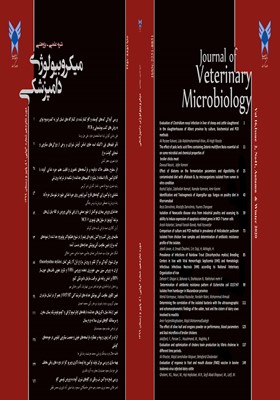بررسی آلودگی کبدهای گوسفند و گاو کشتار شده در کشتارگاه های استان البرز به کلستریدیوم نوای به روش های کشت بیوشیمیایی و PCR
محورهای موضوعی :
میکروبیولوژی
لیدا عبدالمحمدی خیاو
1
*
,
علی رضایی کلوانی
2
,
علی حق روستا
3
1 - مسئول فرمولاسیون واکسن/موسسه واکسن و سرم سازی رازی بخش بی هوازی
2 - کارشناس آزمایشگاه/ بخش بی هوازی موسسه واکسن و سرم سازی رازی
3 - مسئول آزمایشگاه تولید واکسن قانقاریا/موسسه تحقیقات واکسن و سرم سازی رازی بخش بی هوازی
تاریخ دریافت : 1398/02/30
تاریخ پذیرش : 1398/11/15
تاریخ انتشار : 1399/12/01
کلید واژه:
کلستریدیوم نوای تیپ PCR,
B,
تشخیص,
واکسیناسیون,
توکسین آلفا,
چکیده مقاله :
چکیده:کلستریدیوم نوای تیپ B عامل بیماری قانقاریای عفونی کبد می باشد. اسپور باکتری همراه غذا وارد بدن شده و از طریق سیستم لنفاوی وارد کبد می شود. به دلیل شرایط هیپوکسیک کبد زمینه برای تبدیل به فرم رویشی و تکثیر باکتری فراهم شده باکتری مقدار زیادی توکسین تولید نموده که در نهایت منجر به مرگ دام می شود. بنابراین تشخیص توکسین و جداسازی باکتری از دستگاه گوارش دام به خصوص کبد جهت تشخیص این بیماری استفاده می شود. به منظور کنترل بیماری بررسی فراوانی میزان آلودگی ضروری می باشد. هدف از این مطالعه بررسی تعیین شیوع کلستریدیوم نوای در کشتارگاه های استان البرز می باشد. در این تحقیق تعداد ۳۸۶ نمونه کبد از کشتارگاه ها اخذ و پس از آزمایشات باکتریولوژی (کشت در محیط اختصاصی حاوی خون اسب و محیط کشت اختصاصی مایع ، تست حرکت و رنگ آمیزی گرم) و بیوشیمیایی (تخمیر قندها، لیسیتیناز، لیپاز، ژلاتیناز، اندل، هضم شیر و کاتالاز) نمونه ها توسط PCR تأیید نهایی شدند. برای این منظور از پرایمر طراحی شده از توکسین آلفا این باکتری استفاده گردید.نتایج این بررسی نشان داد که میزان آلودگی به این باکتری در کشتارگاه ها ۳۷ مورد (۵/۹٪) بود که ۳۳ مورد (۱۸/۸۹٪) آن آلودگی همزمان به کلستریدیوم نوای و فاسیولا داشتند و تنها در ۴ مورد بدون آلودگی به فاسیولا این باکتری جداسازی و تشخیص داده شد . با توجه به خسارات اقتصادی ناشی از این بیماری به صنعت دامپروی لازم است واکسیناسیون به موقع صورت گیرد.
منابع و مأخذ:
Ardehali, M., Darakhshan, H. (1979). Isolation and typing of Clostridium Oedematiens (C. novyi) from cases of black disease of sheep in Iran. Comparative Immunology, Microbiology & Infectious Diseases, 2: 107–111.
Ardehali, M., Darakhshan, H. (1977). First report of infection with Clostridium oedematiens type D in sheep in Iran. Archives of Razi Institute, 29: 91-93.
Ardehali, M., Derakhshan, H. (1975). The first report of clostridium oedematiens infection in sheep in Iran by the use of Fluorescent labelled antibody. Indian Veterinary Journal, 52: 600.
Ardehali, M., Darakhshan, H., Moosawi, M. (1984). The existence and present situation of clostridial diseases of domestic animais in Iran. Archives of Razi Institute, 34,35: 27-32.
Ardehali, M., Moosawi, M., Avazpoor, J. (1988). Isolation, typing and rapid diagnosis of pathogenic Clostridia from infected animals in Iran. Archives of Razi Institute: 38,39: 35-42.
Ardehali, M., Moosawi, M., Pilehchian, R. (1989). Characterization of Clostridium oedematiens strains isolated from cases of black disease of sheep in Iran. Archives of Razi Institute, 40: 37-45.
Borrmann, E., Schulze, F. (1988).
Detection of Clostridium novyi type B alpha toxin using cell culture systems. ALTEX, 15: 53-55.
Borrmann, E., Schulze, F. (1999). Detection of Clostridium novyi type B alpha toxin by cell culture systems. FEMS Immunology & Medical Microbiology, 24: 275-280.
Busch, C., Schömig, K., Hofmann, F., Aktories, K. (2000). Characterization of the catalytic domain of Clostridium novyi alpha-toxin. Infection and Immunity, 68: 6378-6383.
Gord-Nooshahri, N., Fathi Nahafi, M., Makhdoumi, A., Majidi, B., Mehrvarz, M. (2016). Identification and cloning of highly epitopic regions of Clostridium novyi alpha toxin. Turkish Journal of Biology, 40: 1219-1226.
Heffron, A., Poxton, I.R. (2007). A PCR approach to determine the distribution of toxin genes in closely related Clostridium species: Clostridium botulinum type C and D neurotoxins and C2 toxin, and Clostridium novyi alpha toxin. Journalof Medical Microbiology, 56: 196-201.
Hemmaty, M., Morshedi, A., Yousofbeigi, A., (2006). Fathi Najafi, M. Isolation and identification of Clostridium septicum from sheep-dung. Archives of Razi Institute, 61: 167-172.
Liu, L.L., Jiang, D.N., Xiang, G.M., Liu, C., Yu, J.C., Pu, X.Y. (2014). Development of a cyclic voltammetry method for the detection of Clostridium novyi in black disease. Genetics and Molecular Research. 13: 1724-1734.
Mac Faddin, J.F. (1980). Biochemical tests for identification of medical bacteria. 2thEdition, Lippincott Williams& Wilkins, Baltimore: 572.
Moosawi, M., Ardehali, M., Farzan, A., Pilehchian Langroudi, R. (1999). Isolation and Identification of Clostridium Strains from Cattle Malignant Edema Cases. Archives of Razi Institute, 50: 65–70.
Nyaoke, A.C., Navarro, M.A., Beingesser, J., Uzal, F.A. (2018). Infectious necrotic hepatitis caused by Clostridium novyi type B in a horse: case report and review of the literature. Journal of Veterinary Diagnostic Investigation, 30: 294-299.
Sasaki, Y., Kojima, A., Aoki, H., Ogikubo, Y., Takikawa, N., Tamura, Y. (2002). Phylogenetic analysis and PCR detection of Clostridium chauvoei, Clostridium haemolyticum, Clostridium novyi types A and B, and Clostridium septicum based on the flagellin gene. Veterinary Microbiology, 1,86: 257-267.
Smith, L.D., Holdeman, L.V. (1988). The pathogenic anaerobic bacteria. c.c. Thomas Co., Fort Lauderdale, FL: 109-139.
Sterne, M., Batty, I. (1973). Pathogenic Clostridia typing of Clostridium perfringens. Butterworth, London: 79-82.
Uzal, F.A., Songer, J.G., Prescott, J.F., Popoff, M.R. (2016). Clostridial diseases of animals. Chapter 23. Infectious Necrotic Hepatitis. 1thEdition, John Wiley & Sons, Inc, Hoboken: 275-279.

